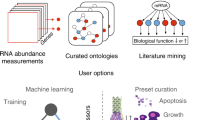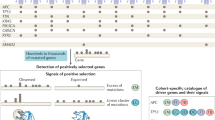Abstract
The ‘gene-centric’ approach has produced a wealth of information about the origins and progression of cancer, and investigators seek a full compilation of altered gene expressions for tumour characterization and treatment. However, the cancer genome appears to be far more unstable than previously thought. It may therefore be prudent to augment gene-level approaches with supra-genomic strategies that circumvent the genomic variability of cancer cells.
This is a preview of subscription content, access via your institution
Access options
Subscribe to this journal
Receive 12 print issues and online access
$189.00 per year
only $15.75 per issue
Buy this article
- Purchase on Springer Link
- Instant access to full article PDF
Prices may be subject to local taxes which are calculated during checkout


Similar content being viewed by others
References
Zhang, L. et al. Gene expression profiles in normal and cancer cells. Science 276, 1268–1272 (1997).
Baylin, S. B. & Herman, J. G. DNA hypermethylation in tumorigenesis: epigenetics joins genetics. Trends Genet. 16, 168–174 (2000).
Moinfar, F. et al. Concurrent and independent genetic alterations in the stromal and epithelial cells of mammary carcinoma: Implications for tumorigenesis. Cancer Res. 60, 2562–2566 (2000).
Bissell, M. J. et al. Tissue structure, nuclear organization, and gene expression in normal and malignant breast. Cancer Res. 59, S1757–S1763 (1999).
Stoler, D. L. et al. The onset and extent of genomic instability in sporadic colorectal tumor progression. Proc. Natl Acad. Sci. USA 96, 15121–15126 (1999).
Strohman, R. C. The coming Kuhnian revolution in biology. Nature Biotechol. 15, 194–200 (1997).
Hanahan, D. & Weinberg, R. A. The hallmarks of cancer. Cell 100, 57–70 (2000).
Nurse, P. Reductionism: The ends of understanding. Nature 387, 657 (1997).
Steeg, P. S. & Abrams, J. S. Cancer prognostics: past, present and p27. Nature Med. 3, 152–154 (1997).
Szallasi, Z. Bioinformatics: Gene expression patterns and cancer. Nature Biotechol. 16, 1292–1293 (1998).
Howard, K. The bioinformatics gold. Sci. Am. July, 58–63 (2000).
Huang, S. & Ingber, D.E. The structural and mechanical complexity of cell-growth control. Nature Cell Biol. 1, E131–E138 (1999).
Loeb, L. A. Many mutations in cancers. Cancer Surveys 28, 329–342 (1996).
Cahill, D. P., Kinzler, K. W., Vogelstein, B. & Lengauer, C. Genetic instability and darwinian selection in tumours. Trends Cell Biol. 9, M57–M60 (1999).
Kinzler, K. W. & Vogelstein, B. Lessons from hereditary colorectal cancer. Cell 87, 159–170 (1996).
Hahnfeldt, P., Panigrahy, D., Folkman, J. & Hlatky, L. Tumor development under angiogenic signaling: A dynamical theory of tumor growth, treatment response and post-vascular dormancy. Cancer Res. 59, 4770–4775 (1999).
Perez-Atayde, A. R. et al. Spectrum of tumor angiogenesis in the bone marrow of children with acute lymphoblastic leukemia. Am. J. Pathol. 150, 815–821 (1997).
Hanahan, D. & Folkman, J. Patterns and emerging mechanisms of the angiogenic switch during tumorigenesis. Cell 86, 353–364 (1996).
Good, D. J. et al. A tumor suppressor-dependent inhibitor of angiogenesis is immunologically and functionally indistinguishable from a fragment of thrombospondin. Proc. Natl Acad. Sci. USA 87, 6624–6628 (1990).
Browder, T. et al. Antiangiogenic scheduling of chemotherapy improves efficacy against experimental drug-resistant cancer. Cancer Res. 60, 1878–1886 (2000).
Klement, G. et al. Continuous low-dose therapy with vinblastine and VEGF receptor-2 antibody induces sustained tumor regression without overt toxicity. J. Clin. Invest. 105, R15–R24 (2000).
Folkman, J. Is tissue mass regulated by vascular endothelial cells? Prostate as the first evidence. Endocrinology 139, 441–442 (1998).
Feinstein, A. R. The santayana syndrome II: Problems in reasoning and learning about error. Perspect. Biol. Med. 41, 73–85 (1997).
Sachs, L. The control of growth and differentiation in normal and leukemic blood cells. The 1989 Alfred P. Sloan Prize of the General Motors Cancer Research Foundation. Cancer 65, 2196–2206 (1990).
Folkman, J. in Accomplishments in Cancer Research (eds Wells, S. A. Jr & Sharp, P. A.) 32–44 (J. B. Lippincott Williams and Wilkins, Pennsylvania 1998).
Perletti, G. et al. Antitumor activity of endostatin against carcinogen-induced rat primary mammary tumors. Cancer Res. 60, 1793–1796 (2000).
Boehm, T., Folkman, J., Browder, T. & O'Reilly, M. S. Antiangiogenic therapy of experimental cancer does not induce acquired drug resistance. Nature 390, 404–407 (1997).
Kerbel, R. S. Inhibition of tumor angiogenesis as a strategy to circumvent acquired resistance to anticancer therapeutic agents. BioEssays 13, 31–36 (1991).
Streit, M. et al. Thrombospondin-2: a potent endogenous inhibitor of tumor growth and angiogenesis. Proc. Natl Acad. Sci. USA 96, 14888–14893 (1999).
St Croix, B. et al. Genes expressed in human tumor endothelium. Science 289, 1197–1202 (2000).
Acknowledgements
We thank G. Anderson, R. Kerbel and B. Vogelstein for reading the manuscript and for their comments. We thank C. Lamont for figure graphics.
Author information
Authors and Affiliations
Related links
Rights and permissions
About this article
Cite this article
Folkman, J., Hahnfeldt, P. & Hlatky, L. Cancer: looking outside the genome. Nat Rev Mol Cell Biol 1, 76–79 (2000). https://doi.org/10.1038/35036100
Issue Date:
DOI: https://doi.org/10.1038/35036100
This article is cited by
-
The effect of obesity on adipose-derived stromal cells and adipose tissue and their impact on cancer
Cancer and Metastasis Reviews (2022)
-
Morphine decreases the pro-angiogenic interaction between breast cancer cells and macrophages in vitro
Scientific Reports (2016)
-
Enhanced therapeutic anti-tumor immunity induced by co-administration of 5-fluorouracil and adenovirus expressing CD40 ligand
Cancer Immunology, Immunotherapy (2014)
-
Application of medical gases in the field of neurobiology
Medical Gas Research (2011)



